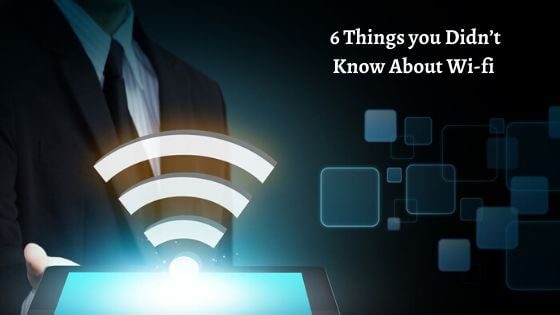6 Things you Didn’t Know About Wi-fi
Science and technology have been the two driving forces of the world from the past few decades. It is hard to pin down a country that has remained untouched by its utility. The developing and ever-growing roots have penetrated in every sector around the world and are becoming an indispensable part of it. It is hard to list the gifts that it has pioneered for the human race. Still, one of it requires acknowledgment, given its increasing use has made it inevitable, it is the internet.
Tracing its inception from the year 1983, the internet has to be the only impalpable commodity that has never seen a sinking demand. Being provided initially through bulky hardware, not only its speed has been cranking up, even the hardware is losing its bulkiness as evident from the Wi-Fi devices at our places.
Wi-Fi is a piece of wireless networking technology that, through the use of radio waves, provided its user the internet facility. Nowadays, it is easy to spot Wi-Fi even at a marginalized family’s house as it is no longer a luxury and instead has become a necessity. However, there are a few things you won’t be enlightened about in the context of Wi-Fi. You can learn more about WiFi from this Router Login website as well. Here are those few facts that shall be surprised to know and would probably make you the smarter and more informed one among your peers.
1. Wi-Fi was conceived in Hawaii
Hawaii, the world’s largest island chain and famous as a vacation spot for many, was where Wi-Fi was devised. Though won’t many would agree, but the forerunner of Wi-Fi was invented in Hawaii 1971 at the University of Hawaii and was called the ALOHAnet. After 20 years NCR Corporation and AT&T Corporation invented what they called WaveLAN, and it was followed by the launch of the IEEE 802.11 wireless protocol’s first version.
2. Wi-Fi harnesses the radio waves
Radio waves are the electromagnetic radiations that have different wavelengths measured in terms of frequencies. Wi-Fi works on the same principle as other wireless devices- send signals between devices using radio waves. Unlike the radio frequencies of cellular gadgets or radio, the frequency of Wi-Fi ranges between 2.4GHZ to 5 GHz.
For sending or receiving Wi-Fi radio waves, data is converted or encoded by a wireless router to radio signals, which is obtained by another router or adapter and decoded to original data. Two routers work in tandem to encode and decode the radio signals.
3. Human body decelerate the speed of Wi-Fi
About 70% of the human body is made of water, and water acts as a signal blocker. If you would be sitting between your router and computer, your body will disrupt the signals, and the speed of Wi-Fi will ultimately slow down. Some other signal blockers are wood and metal, a significant one among them being the metal. Other reasons for lagging Wi-Fi signals can be outdated hardware, the position of the router, or probably your device can’t handle the speed.
Also Read: Top 10 Amazing Face Recognition Apps of 2020 You Should Use
4. Wi-Fi and IoT applications don’t go hand in hand
IoT is the concept of connecting all physical devices to the internet. Though Wi-Fi is compatible with tools like a surveillance camera, in-home electronic appliances, and other such doohickeys, it might not work fine with other IoT applications.
Some applications have small sensors that require a battery to power and don’t need the transmission of tons of data. Wi-Fi is used for the information of a high amount of data with high power consumption and within low range, hence Wi-Fi isn’t a great option in such cases.
5. Speed of Wi-Fi improves when other devices are unplugged
Well, one can say Wi-Fi doesn’t like other players in the field when it is operational. It is vulnerable to interference as the radio signals it transmits can bump into other signs of the same frequency, and this leads to buffering in devices.
The usage of other applications acts as interference for Wi-Fi as it seems to challenge its speed. To reduce this interference or disruption, unplugging devices like Bluetooth, printer, smart TVs, etc. can help.
This shall reduce the signal traffic and intervention, and the Wi-Fi shall resume his dominance in the room. Even moving Wi-Fi closer to the computer or laptop can enhance its operationally, and efficiency improves.
6. Two devices connected to the same Wi-Fi can share files
You will be surprised to know that Wi-Fi that provides internet service to you can even enable you to share documents and other files to devices connected to the same network.
Requirements for the same shall be range must be small, like within your house and granting specific users the access to select files, documents, and folders from your device. The most common and easy to share files are movies, music, and videos that are licensed or stored on other devices.
Hence above were some facts and information you probably weren’t aware of earlier, and you can make out that being a tech geek can earn you some respect among your colleagues and peers.




